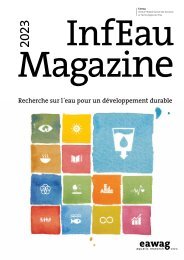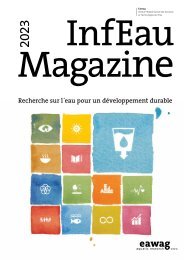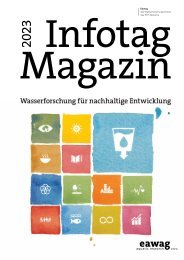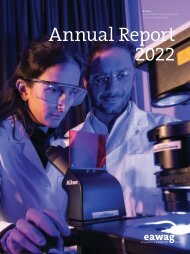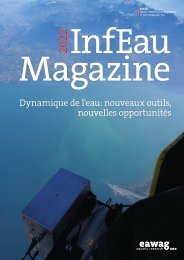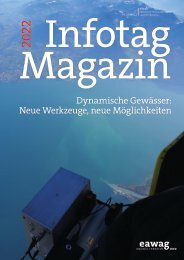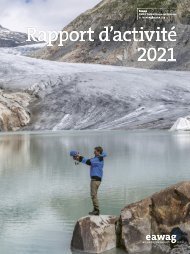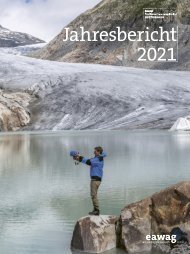Eawag Annual Report 2021
The Annual Report gives a wide-ranging account of current Eawag projects. It is published in English and German, and since 2013 also in French.
The Annual Report gives a wide-ranging account of current Eawag projects. It is published in English and German, and since 2013 also in French.
You also want an ePaper? Increase the reach of your titles
YUMPU automatically turns print PDFs into web optimized ePapers that Google loves.
LEHREN<br />
23<br />
Christoph Vorburger, <strong>Eawag</strong><br />
What can be done to protect native crayfish?<br />
Photo Crayfish play an important<br />
role in river ecosystems:<br />
these omnivorous creatures<br />
decompose leaf litter or the<br />
remains of dead fish.<br />
Native species of crayfish – formerly widespread – have now almost completely disappeared<br />
from large rivers in Switzerland. To help preserve surviving populations,<br />
<strong>Eawag</strong> is reaching out to experts with a practice-oriented (PEAK) course.<br />
PEAK<br />
Programme<br />
Crayfish are among the largest invertebrates found in<br />
Swiss waters, but people’s knowledge of these nocturnal<br />
river dwellers remains limited. For thousands<br />
of years, native species such as the stone, whiteclawed<br />
and noble crayfish were widely distributed<br />
throughout Europe. Today, these species have almost<br />
completely disappeared from large waterbodies in<br />
Switzerland. What exactly has happened? And what<br />
measures is Switzerland taking to support the surviving<br />
populations?<br />
Dramatic decline<br />
These questions were discussed by practitioners<br />
attending a PEAK course in Tolochenaz (by Lake Geneva)<br />
entitled “Protection of native crayfish.” It was<br />
explained that, in many waterbodies, there is a lack<br />
of natural structures to provide shelter for crayfish.<br />
Also problematic is the contamination of rivers with<br />
pesticides and heavy metals.<br />
The situation deteriorated sharply when, from the<br />
19th century onwards, North American species such<br />
as the signal or red swamp crayfish were introduced<br />
to Europe. These invasive species not only outcompeted<br />
native crayfish for habitat, but also brought crayfish<br />
plague to Europe.<br />
Enhancement measures<br />
Today, native crayfish are only to be found in the upper<br />
reaches of certain rivers, surviving in largely isolated<br />
residual populations. However, according to Christoph<br />
Vorburger, Head of the Aquatic Ecology department,<br />
Adjunct Professor at ETH Zurich and organiser of the<br />
PEAK course on crayfish, “It is possible for waters<br />
to be enhanced in such a way that they become habitable<br />
for crayfish again. To preserve the remaining<br />
populations, there is a need for protection efforts –<br />
and dialogue with practitioners, which we facilitate<br />
through our course.”



